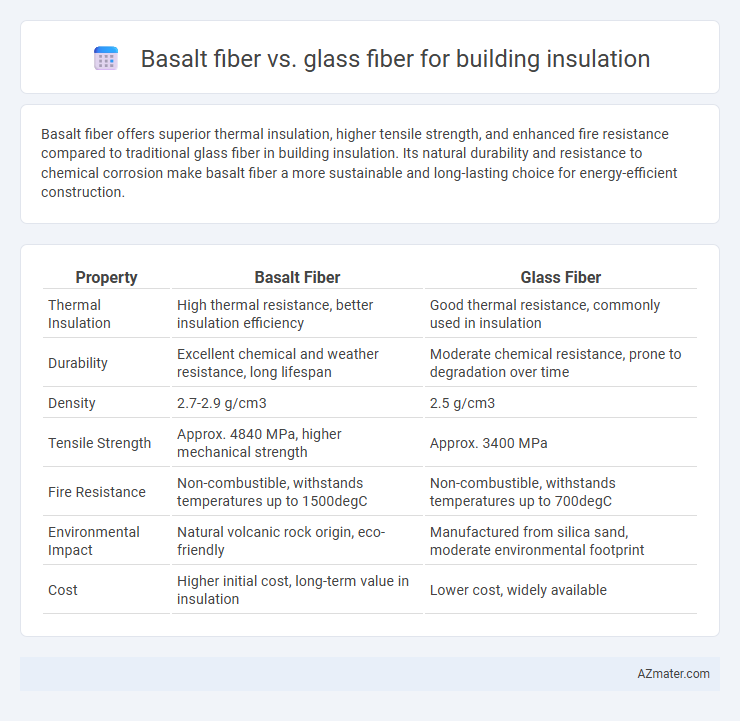Basalt fiber offers superior thermal insulation, higher tensile strength, and enhanced fire resistance compared to traditional glass fiber in building insulation. Its natural durability and resistance to chemical corrosion make basalt fiber a more sustainable and long-lasting choice for energy-efficient construction.
Table of Comparison
| Property | Basalt Fiber | Glass Fiber |
|---|---|---|
| Thermal Insulation | High thermal resistance, better insulation efficiency | Good thermal resistance, commonly used in insulation |
| Durability | Excellent chemical and weather resistance, long lifespan | Moderate chemical resistance, prone to degradation over time |
| Density | 2.7-2.9 g/cm3 | 2.5 g/cm3 |
| Tensile Strength | Approx. 4840 MPa, higher mechanical strength | Approx. 3400 MPa |
| Fire Resistance | Non-combustible, withstands temperatures up to 1500degC | Non-combustible, withstands temperatures up to 700degC |
| Environmental Impact | Natural volcanic rock origin, eco-friendly | Manufactured from silica sand, moderate environmental footprint |
| Cost | Higher initial cost, long-term value in insulation | Lower cost, widely available |
Introduction to Building Insulation Materials
Basalt fiber and glass fiber are prominent materials in building insulation due to their durability and thermal resistance properties. Basalt fiber offers higher temperature stability, enhanced mechanical strength, and superior fire resistance compared to glass fiber, making it a preferable choice for high-performance insulation. Glass fiber remains popular for its cost-effectiveness, ease of installation, and widespread availability in traditional insulation applications.
Overview of Basalt Fiber
Basalt fiber, derived from natural volcanic rock, offers superior thermal insulation and high resistance to heat compared to traditional glass fiber, making it ideal for building insulation applications. Its enhanced durability, chemical stability, and sound absorption properties contribute to improved energy efficiency and indoor comfort in construction projects. Basalt fiber's eco-friendly production process and recyclability position it as a sustainable alternative to conventional glass fiber insulation materials.
Overview of Glass Fiber
Glass fiber, widely used in building insulation, is composed of fine strands of glass woven into mats or blankets that provide excellent thermal resistance and fire retardancy. Its affordability and lightweight properties make it a preferred choice for residential and commercial insulation applications. Glass fiber also offers soundproofing benefits and moisture resistance, contributing to energy efficiency and indoor comfort.
Thermal Insulation Performance Comparison
Basalt fiber offers superior thermal insulation compared to glass fiber due to its higher melting point of approximately 1450degC and lower thermal conductivity, typically around 0.035 W/m*K, enhancing energy efficiency in building applications. Glass fiber insulation, with a melting point near 820degC and thermal conductivity ranging from 0.040 to 0.045 W/m*K, provides adequate but less effective heat resistance. The improved thermal stability and insulation performance of basalt fiber contribute to better protection against temperature fluctuations and reduced energy costs in construction.
Mechanical Strength and Durability
Basalt fiber exhibits superior mechanical strength compared to glass fiber, with tensile strength ranging between 2,800 to 4,800 MPa, enhancing its effectiveness in building insulation under high-stress conditions. Its exceptional durability stems from high chemical resistance and thermal stability up to 700degC, outperforming glass fiber, which typically withstands temperatures around 450degC. These properties make basalt fiber a more resilient and long-lasting choice for insulation applications in construction environments exposed to extreme mechanical and thermal stress.
Fire Resistance and Safety
Basalt fiber exhibits superior fire resistance compared to glass fiber, withstanding temperatures above 1000degC without melting or releasing toxic fumes, making it a safer choice for building insulation in fire-prone environments. Unlike glass fiber, basalt fiber maintains structural integrity under extreme heat, reducing the risk of fire spread and enhancing occupant safety. Its non-combustible nature and low smoke emission contribute to better fire safety performance, meeting stringent building codes and regulations.
Moisture and Chemical Resistance
Basalt fiber exhibits superior moisture resistance compared to glass fiber, maintaining structural integrity and insulation performance in humid environments by resisting water absorption and preventing mold growth. Chemically, basalt fiber is highly resistant to acids, alkalis, and corrosive substances, which enhances durability and longevity in aggressive industrial or marine conditions. Glass fiber typically shows lower resistance to chemical exposure and moisture, potentially leading to degradation, reduced insulation efficiency, and shorter service life.
Environmental Impact and Sustainability
Basalt fiber insulation offers superior environmental benefits compared to glass fiber by utilizing natural volcanic rock and requiring less energy during production, resulting in lower carbon emissions. Basalt fibers are non-toxic, recyclable, and resistant to degradation, enhancing long-term sustainability in building applications. Glass fiber insulation, while widely used, involves higher energy consumption and emits more pollutants during manufacturing, contributing to a larger ecological footprint.
Installation and Cost Considerations
Basalt fiber insulation offers easier installation due to its flexibility and resistance to moisture, reducing the risk of mold and structural damage compared to glass fiber. While basalt fiber tends to have a higher upfront cost, its durability and thermal efficiency can lower long-term expenses by minimizing maintenance and energy consumption. Glass fiber remains a more economical option initially but may require more frequent replacement and careful handling during installation to avoid health hazards.
Conclusion: Choosing the Right Fiber for Building Insulation
Basalt fiber offers superior thermal stability, higher tensile strength, and increased chemical resistance compared to glass fiber, making it an excellent choice for demanding building insulation applications. Glass fiber remains cost-effective and widely available, providing good insulation properties for standard construction needs. Selecting the right fiber depends on balancing performance requirements, environmental conditions, and budget constraints to ensure optimal building insulation efficiency.

Infographic: Basalt fiber vs Glass fiber for Building insulation
 azmater.com
azmater.com